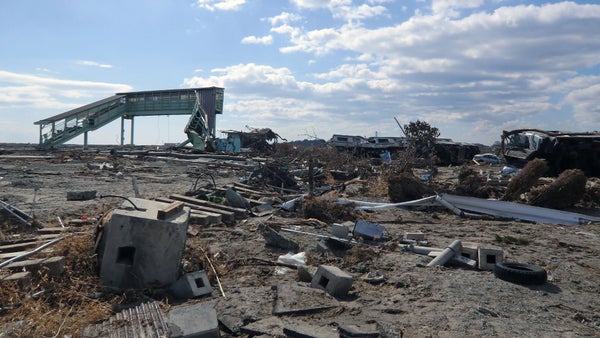Deep below the surface of the ocean and the floor below it there is a gentle, slow and nearly silent phenomenon that for decades has remained invisible to geologists. Discovered in the 1990s, so-called “slow-slip events” or just “slow earthquakes” are gentle ruptures in fault lines that may play a role in large, more destructive quakes.
In a new report this week in Science, seismologists say that whereas slow quakes may not predict big, dangerous ones in the way a weather forecaster can predict a hurricane days before it hits, the slow movements may still tell them about earthquake dynamics and when a fault system has become dangerous. “Slow earthquakes may function as stress meters,” Aitaro Kato, a seismologist at the University of Tokyo and a co-author of the Science review, wrote in an e-mail.
“The discovery of slow earthquakes and our ability to study with modern technology has really opened up a whole new chapter in how we look at faults and their mechanics,” says Roland Bürgmann, a seismologist at the University of California, Berkeley whose work linking slow earthquakes to larger ones was cited in the paper.
On supporting science journalism
If you're enjoying this article, consider supporting our award-winning journalism by subscribing. By purchasing a subscription you are helping to ensure the future of impactful stories about the discoveries and ideas shaping our world today.
Earthquakes often occur as plates of the planet’s crust push against each other, building up pressure in the boundary area until eventually it rips all at once in a potentially violent adjustment, called a megathrust. It turns out that occasionally those faults will also shift more slowly—on the order of a few centimeters over days, months or years, which is still faster than normal plate movement.
The relationship between these slower, smoother rumbles and their noisier cousins is not exactly clear. Perhaps they are caused by the same forces that cause the larger quakes. Or perhaps they actually help trigger the larger ones, either by building up pressure on the fault past some unknown threshold or by essentially shaking the fault loose so that it snaps.
Because they happen so slowly and at low frequencies, slow earthquakes are hard to measure and track. But careful analysis of the buildup to the 2011 Tohoku quake, which caused the tsunami that triggered the Fukushima meltdown, showed that it was preceded by an increasing number of slow earthquakes directly around the rupture zone. A similar trend occurred before the 2014 Iquique earthquake in Chile.
Slow quakes may, in fact, produce tremors that put pressure on a specific area and prime it to snap. But these forces can be very subtle. For instance, no one had ever recorded slow earthquakes around the Tohoku region before the magnitude 9 quake hit. But a careful analysis by the University of Tokyo revealed a deep, decadelong slow-slip event that led up to the temblor. The deepest section even seemed to accelerate up to the quake.
The question is, how can we recognize such events in the future? It seems clear that slow earthquakes can drive swarms of small events. Off the coast of Japan these swarms and slow-slip behaviors seem to loosely follow a schedule and to coincide with bigger quakes.
Bürgmann says that such swarms preceded the 1992 Landers quake in southern California and may have been tied to a slow-slip event that scientists could not detect. He adds that slow earthquakes also do not seem to prefer any particular type of fault and thus may be useful in many places. The tectonic plates in California grind side by side whereas in Japan one thrusts itself underneath the other. Yet both seem to produce slow earthquakes that interest seismologists.
Japan, however, is years ahead of the U.S. in earthquake research. The Japan Agency for Marine–Earth Science and Technology recently finished a monitoring system that connects pressure sensors and cutting-edge seismometers via underwater cables that report tiny changes to the fault in real time. When the data begins coming in, it will be one of the best places on Earth to look for slow quakes. Even so, Kato warns not to get one’s hopes up. “Slow earthquakes could lead to an increased probability of megathrust events,” Kato wrote, “but there have been few observations to confirm or refute this hypothesis statistically.”
In the end, the authors point out that the study of slow earthquakes may be less a tool of prediction, which many seismologists see as impossible, and more of sort of geologic barometer, showing how dangerous a fault system has become. In theory, after a long period of slow earthquake activity in a particular region seismologists might someday issue warnings that a certain area is likely to see a big event in the following years. It would be less a prediction and more a sort of threat level measurement.
And because a key driver of slow earthquakes may be fluid moving through Earth’s crust, slow quakes may help us understand the tremors that frequently accompany fracking to extract fossil fuels. But it will be a long time before we understand these connections and certainly no one is talking about earthquake prediction.
“The ‘prediction’ word is almost a bad word,” Bürgmann says. His colleagues are very reluctant to overpromise. Yet, he says, “there is this intermediate level between prediction and forecasting. And I think eventually it would be quite reasonable to think we can achieve that.”
